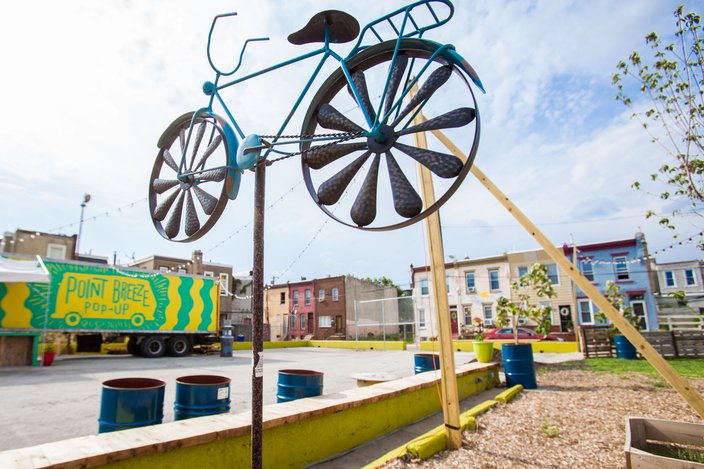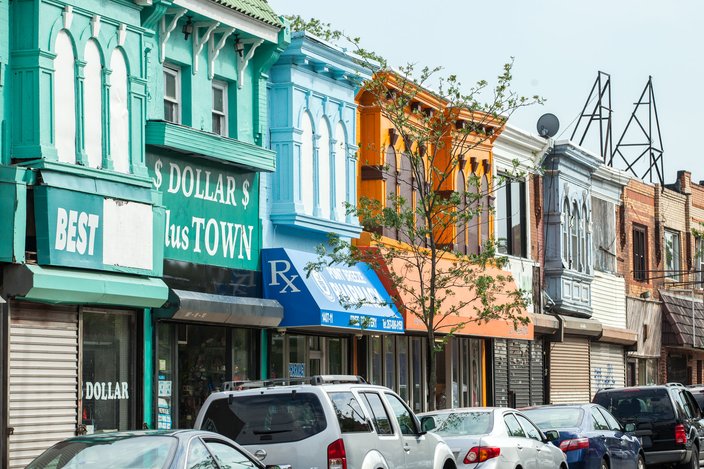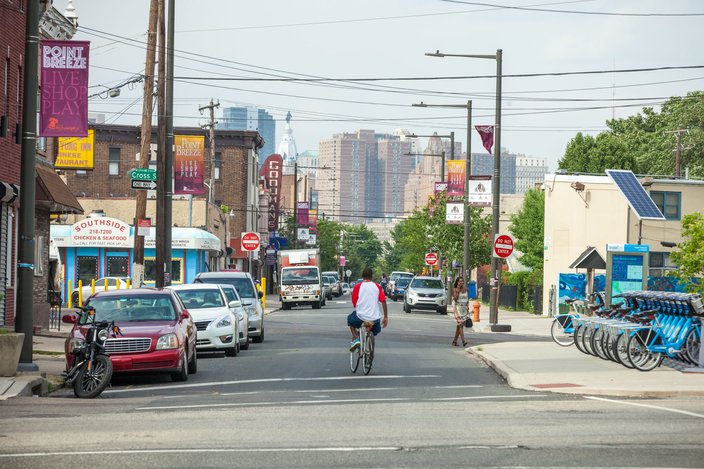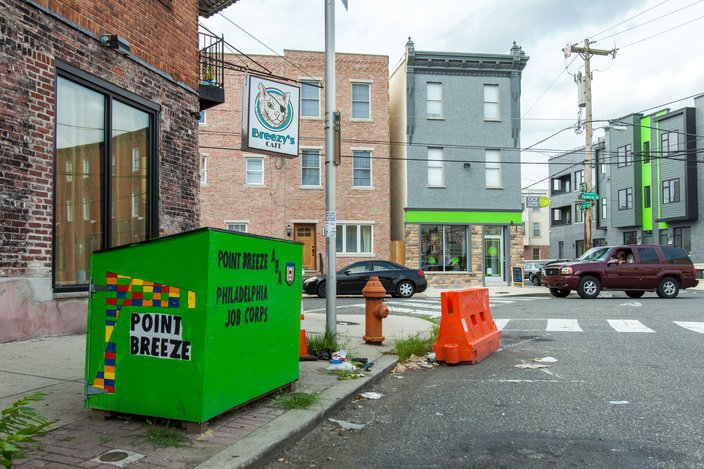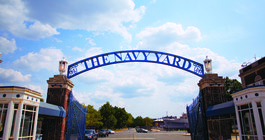
July 01, 2015
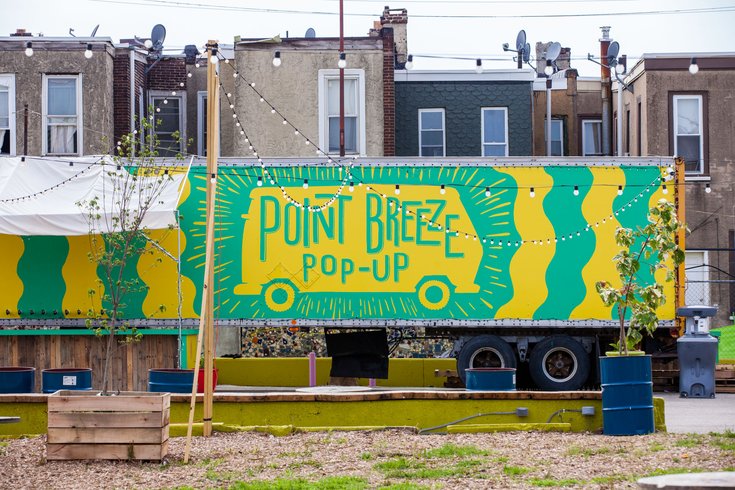 Thom Carroll, File/PhillyVoice
Thom Carroll, File/PhillyVoice
The Point Breeze Pop-Up Garden at 1622 Point Breeze Ave. opened in May 2015 with an 18-wheeler-turned-bar, lunch trucks and an array of plants.
It all started with a pop-up.
On May 16, an otherwise uncontroversial pop-up garden surfaced at 1622 Point Breeze Ave. To anyone familiar with the neighborhood, you could be fooled into thinking it was a mirage -- an unlikely birthing ground for an entertainment concept you'd expect to find occupying lots in major commercial corridors like South Street or Columbus Boulevard.
The initial reaction, to put it mildly, was a mix of confusion and chaos. A mysterious (and antagonizing) flier appeared on the avenue on June 4 that pegged the pop-up's initiator, John Longacre, as the new Ori Feibush -- Point Breeze's most polarizing developer, who's built hundreds of new row homes in the neighborhood since 2008. The flier culminated in a particularly divisive and unfruitful community meeting called by State Rep. Jordan Harris. The complaint: Despite efforts by Longacre to spread the word, residents had heard nothing about a pop-up coming to the avenue.
Cue a wave of community outrage, followed by a quick crashing of that wave back into the water, tapering into a long silence -- as if the whole uproar had never happened.
But what got lost in that knee-jerk community-meeting hysteria and incendiary gentrification Op-Eds is what the Point Breeze Pop-Up Garden represents from a 35,000-square-foot vantage point: renewed interest in a commercial corridor that long ago lost its luster, but never its heart.
It is, to be sure, a sign of gentrification -- but also of rebirth.
"Before they moved that garden over there, it was a dump," a Point Breeze man locally referred to as "Wala Wala," who lives directly across from the pop-up, told PhillyVoice outright. "It was garbage, trailers, old trucks. For 30 years, I rode by here, and it was a dump."
Though, most residents can recall when the avenue wasn't a "dump."
Point Breeze Avenue, or "The Breeze," as it's called by longtime residents, hasn't been a significant commercial corridor for decades. And while "dump" might not be the most tactful choice of words, it wouldn't be a stretch to call the avenue a relic of its former self. It's what makes the garden's existence -- what, with its food trucks, yoga and beer -- such a curious one.
Because for residents who remember a bustling Point Breeze Avenue, the garden is a symbol of hope.
“When I was little -- we’re talking early-to-mid-'70s -- 'The Breeze' was very active. There were a lot of mom-and-pop stores, butchers -- things like that," Erica McLean, a resident and former schoolteacher who's been in and out of the neighborhood for five decades, told PhillyVoice. "I used to go all the time with my grandparents to buy things. Back then, you really didn’t have to leave the neighborhood for anything."
"Now," she added, "it's coming full circle. People are taking pride in the neighborhood and keeping [their] money here. And I'm happy about that."
While there are certainly small signs of the avenue piecing itself back together commercially -- a new pharmacy, a wine and spirits store, several small take-out restaurants and an herb shop -- it's also true that much of its business left and never came back after Jewish residents, who owned and operated much of what was on the avenue, fled for the suburbs. What's left is vacant lots abound.
On the horizon, though, is a post-pop-up project activating a thought that should have been the focal point of the garden's narrative all along: While the pop-up's presence is temporary, commercial life on The Breeze might not have to be.
And if a South Philly developer has his way, it won't be.
Fact: The pop-up garden will be gone in September. That won't change. However, it's not true that the space will return to its former state of vacancy once its array of merchants pack up for good.
That was never the plan for Longacre, who owns LPMG Properties and is responsible for the pop-up in the first place.
"It's a test to see what we can do there," he told PhillyVoice.
By implementing a space filled with amenities like food trucks, a produce cart and community programming, Longacre -- the man behind South Philadelphia Tap Room and American Sardine Bar -- wanted to experiment with how much interest merchants could generate in a neighborhood that's less densely populated than an average (and more ideal) commercial site. Considering the garden has, he said, attracted "thousands" since its May opening, he's considering the experiment a pretty successful one.
Longacre: The goal is to revitalize that commercial corridor. ... What we'd like to do is build something cool there that's a combination [of residential and commercial].
Now, Longacre is thinking long-term.
"The goal is to revitalize that commercial corridor," Longacre explained. "And there’s two parts to that: You need amenity businesses, and you need residents. The residents won’t move in where there aren’t any amenity-based businesses, and amenity-based businesses won’t go where there aren’t residents. It’s a tricky balancing act, and what we’d like to do is build something cool there that’s a combination of both [residential and commercial]."
So, pending approval this fall (he's asking for zoning variances), what will replace the garden is an LEED-certified, mixed-use development. His plan, he told PhillyVoice, is to fill the 30,000-square-foot lot with 53 residential units -- most of which will be market rate -- and work with the community to offer an unspecified number of affordable units. The lot will also feature a courtyard facing 23rd Street, and about five commercial spaces facing Point Breeze Avenue -- with the potential for 10, when taking into account a string of parcels he plans to develop across the street.
The former lack of interest in the avenue, he said, boils down to this: "People want to live near cool stuff."
The Point Breeze Pop-Up Garden opened in May at 1622 Point Breeze Ave., between Tasker and Morris streets. A 53-unit residential development, mixed with about five to 10 commercial units, will be proposed in the fall. Thom Carroll / PhillyVoice
And, frankly, they want to build around cool stuff, too.
Longacre's hope is to fill the commercial spaces with privately owned businesses "that can draw from other places to stay alive," and allow developers to "build residential around it."
Which, of course, is exactly the approach Longacre and his property management company took with South Philadelphia Tap Room about a decade ago, in what's often referred to as the "Newbold" neighborhood running southeast of Point Breeze Avenue. In that scenario, Longacre similarly took a dilapidated space at 16th and Mifflin streets and turned it into a bar-restaurant, and then built around that in a major way with 16 row homes and two condos planted at the corner of 16th and Moore streets.
The mystery, though, is whether that same strategy can work for Point Breeze Avenue.
"Can we draw a population there? I don't know. It's tricky," Longacre admitted. "We're rolling the dice."
But it's a gamble that could come with a huge pay-off -- for him and the neighborhood.
Look, Longacre's ambitions are all well and good -- his development is infill (no one is being displaced), and his approach has been tested before and met with some success (depending on who you ask). But he's also building in a neighborhood of skeptics and more vacant lots than was ever typical of, say, East Passyunk Avenue.
Residents' support matters, and Longacre got off to a rough start at the June 4 meeting, where he was described by one reporter as "mocking" residents.
"I absolutely had a mocking tone," Longacre said. "When I got to the point where nothing I said was going to be met with any listening or understanding, when I'm told I own rec centers I don’t own, and when it just became absolute bullshit, my tone went mocking. And do I regret it? Absolutely."
Despite the flub, he's still managing to grab the support of one of the neighborhood's key players: Claudia Sherrod, president of the Point Breeze RCO and social services organization South Philadelphia H.O.M.E.S.
A resident of Point Breeze for 55 years, and a woman who has her finger on just about every pulse of the community, few other Point Breeze leaders matter as much as she does.
In short, Sherrod thinks it's the avenue's best shot in years at renewing interest in the commercial corridor. Will she support it? That's a wait-and-see -- but she's certainly interested in the general idea of bringing the corridor back to its former glory.
“I think it will [generate interest], and I think once you put it there and get people to agree to it, it will open up a whole new avenue," Sherrod told PhillyVoice.
That said, Sherrod's hoping to see commercial businesses that the surrounding neighborhoods can take advantage of -- bringing The Breeze back to a time when residents didn't have to "cross the tracks" (Broad Street) to get basic needs like produce, clothing and hardware supplies.
Though it recently opened a new pharmacy (pictured), Point Breeze Avenue long ago lost the bulk of its businesses, which previously included restaurants, three movie theaters, a candy shop and several clothing retailers. Thom Carroll / PhillyVoice
"I’d like to see things that offer an opportunity for neighbors to come out and purchase items, maybe eat on the Breeze – but nice eateries," she said. "We don’t need more fast food; we need eateries."
Councilman Kenyatta Johnson, who serves the Second District and just won a contentious electoral brawl against Ori Feibush, is also on board with redevelopment of Point Breeze Avenue -- whether it's through Longacre's project or not.
“It’s my hope that [the avenue] will develop in a similar fashion as East Passyunk, and even beyond," Johnson told PhillyVoice, referring to that corridor's ability to (mostly) please all parties.
The thought process is that The Breeze will first develop in accordance to the needs of its neighbors and, after doing so, trigger interest from outside of it. Johnson said he's working with the Greater Philadelphia Chamber of Commerce to develop a strategic plan for luring businesses to the commercial corridor of Point Breeze Avenue, and is also working with Point Breeze Pharmacy to transform a large city-owned vacant lot on on the avenue into a mixed-use development, to include a new pharmacy and "community-oriented retail" on the ground floor, mixed with affordable apartments above.
Councilman Kenyatta Johnson: It’s my hope that [the avenue] will develop in a similar fashion as East Passyunk, and even beyond.
But it would be disingenuous to suggest there aren't neighbors wishing for a more aggressive plan.
Steve Sabo, director of the Point Breeze Community Development Corporation, which advocates for business development in Point Breeze, insists that the stifler of Point Breeze Avenue redevelopment is one the councilman could address, but has yet to.
"One of the biggest problems is that it’s severely under-zoned," Sabo told PhillyVoice. "The neighborhood as it stands isn’t yet dense enough to support a business on its own, so if a restaurant were to move in right here on the 1200 block of Point Breeze Avenue, it would probably fail, because there wouldn't be enough [foot traffic]. So, in order to help your business survive, you need to have supplemental income -- in this case, in the form of rental units."
That zoning change, he said, would allow for more residential apartments to be built on top of commercial spaces and, ideally, would build up a base of customers for new businesses.
"There’s one person who could make it happen at the snap of a finger, and I don’t see that happening any time soon," Sabo said, referring to the councilman.
Johnson's response is that South Street West -- and other commercial corridors in the city -- have developed without an upgrade to CMX-3 zoning, which increases height limits to five times the property size, rather than capping out at 38 feet for CMX-2. He pointed to a recent report from the Philadelphia Planning Commission as an example of why there's little incentive to up-zone.
Councilman Kenyatta Johnson recently had promotional banners and BigBelly solar trash cans installed on Point Breeze Avenue in an attempt to jumpstart efforts toward its revitalization. An Indego Bike Share station was also recently installed. Thom Carroll / PhillyVoice
"The commission recommends that the bulk of the avenue remain CMX-2, a designation found on other neighborhood commercial corridors like South Street West, which has recently experienced a resurgence of its own," Johnson explained. "Over the next few years, I believe that Point Breeze Avenue will begin to attract some of the types of small businesses we currently see [there]."
South Street West, also in the Second District, is primarily zoned CMX-2 and is home to businesses like Pumpkin, Bob and Barbara's, Mushmina, Miss Tootsie's and Magpie, to name a few.
But then again, South Street isn't Point Breeze.
Can Point Breeze Avenue emerge as the East Passyunk Avenue of Southwest Philadelphia?
Yes, but not without time, investment (lots of it) and, most importantly, residential input -- a need that far exceeds any up-zoning at this point.
What Point Breeze Avenue faces is a bevy of hurdles -- racial politics, class conflict, low density, lack of a business improvement district, etc. -- that other developing commercial corridors like East Passyunk Avenue never faced to such extreme degrees. Simply put, there's not much likelihood you'll be grabbing dinner west of the tracks at Laurel II any time soon, but don't count it out in the future.
Hope is in abundance for The Breeze's future right now; not since the Point Breeze RCO commissioned a neighborhood planning report in 2005 -- which called for a "reinforced avenue" and a change of both "shopping patterns" and "small parcels ill-suited to new commercial uses" -- has there been such interest in redeveloping the commercial corridor.
The key will be whether developers like Longacre know how to spend that new hope, and whether they continue to take the community The Breeze was born from into consideration.
"I tell people all the time: ‘If you want to be successful and open a business, at this point in time, you need to be mindful of people who exist here. And if you want it to pass through the RCO, you need community support,’" Haley Dervinis, who's on the zoning committee for the Point Breeze Community Development Coalition, told PhillyVoice. "Nine times out of 10, they do not listen to me, and they ram a project down people’s throats, and then they get mad. ... If you want people to get excited about your project, you need to engage them.”
The intersection at 20th and Federal streets and Point Breeze Avenue, where OCF Coffeehouse and Breezy's Cafe anchor the northern end of the avenue. Thom Carroll / PhillyVoice
That lack of engagement from many developers, she said, is often the source of the headlining hullabaloo so typical of Point Breeze -- a cyclical spat between longtime residents who may want change but don't want pushed out, developers who are sometimes guilty of a Father Knows Best approach and those who fall somewhere in the middle.
'I tell people all the time, ‘If you want to be successful and open a business, at this point in time, you need to be mindful of people who exist here,' said Haley Dervinis, member of the Point Breeze zoning committee. 'And if you want it to pass through the RCO, you need community support'
The truth of what kind of development people want for Point Breeze Avenue is that no one really knows -- because, Dervinis said, long-term development is seldom discussed at large-audience meetings, which tend to be preceded by reality-skewing social media posts or panic-inducing fliers. Longacre, too, noted that in the case of the June 4 community meeting, most residents who put in face time had "already made up their mind about me," regardless of what the truth actually was.
Still, it's not all shouting matches and negativity in the neighborhood.
Shaun Miller, a 30-year-old Point Breeze resident who grew up in the neighborhood, recalled recently seeing more local African-American residents at the pop-up garden than before the controversial community meeting last month. That, he said, gave him hope that there's honest discussion still to be had about what people want from a rejuvenated Breeze.
Shaun Miller at the Point Breeze Pop-Up Garden. From Instagram
Because the real debate isn't over whether residents want a developed avenue; it's what will go in it.
"I’d like to keep that sense of 'This is our community,'" Miller told PhillyVoice, warning that he wouldn't want The Breeze to be quite as "white-table-cloth" as East Passyunk can be. "I want to see people open businesses here who are invested in the community and from the community, rather than just having someone come from the outside to make money."
Indeed, Domenic Vitiello, associate professor of city planning for the University of Pennsylvania, told PhillyVoice that producing small businesses for low-income neighbors -- not just high-priced cafes -- is, in fact, "similarly as important" as other well-publicized inclusionary steps in gentrifying neighborhoods, like home-finance counseling, affordable housing options, "aging-in-place" services for seniors and energy assistance.
In which case, Longacre -- Feibush, and everyone else who decides to build on The Breeze -- might be wise to partner with trusted community leaders to make sure the avenue does develop as a community-led commercial corridor. Or, at least in a way that is conscious that Point Breeze Avenue isn't a neighborhood that's been discovered; it's a community that has been there all along -- even after its many shops shuttered.
"A diverse neighborhood is a strong neighborhood," Councilman Johnson said, summing up his goals. "Development is about listening to the needs of the neighborhood, and implementing policies that address those needs."
And in that sense, all parties can start by taking seriously the need every Point Breeze neighbor and developer unquestionably has in common: an overwhelming desire to be heard.
